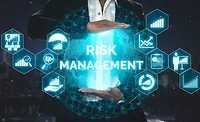Preparing for the expected for stronger risk management

Image via Unsplash
Sanctions, ransoms, banking failures and supply chain woes — less than halfway into 2023 and security leaders continue to see how today’s world events can affect any industry at any time. Businesses without a clear risk strategy need to articulate one, and quickly, because they face increased volatility across all operations and business units, from compliance to third-party to cyber and IT. With this rapid velocity of new and emerging risks defining the current risk landscape, it’s crucial for organizations to stay risk-aware and know where internal vulnerabilities lie, so they can strive to minimize disruption while maintaining regulatory compliance and ensuring quicker response in case of an adverse event.
An effective enterprise risk management (ERM) program is how organizations gain visibility into the risk exposure of business activities across the extended enterprise.
Traditionally, ERM programs have been a tick-in-the-box activity where individual offices or business functions evaluated risks separately, resulting in information siloes and duplication while creating risk oversight. This “reactive” approach to ERM is no longer effective for addressing the new and emerging risks facing organizations, including advanced cyber threats, geopolitical risk, ESG risks, third-party and supply-chain risks, a talent exodus and various new forms of human-factor risks.
Navigating today’s adversities requires a robust ERM approach that encourages collaboration across the aisle — so organizations can make better, risk-aware decisions. This not only helps optimize reporting, protect assets and ensure business continuity, but also enables organizations to take bigger risks, seize opportunities and gain a competitive advantage.
Here’s how organizations can take a pervasive, collaborative approach to strengthen their risk management programs and empower owners with better data for more informed decision-making.
Creating enterprise-wide visibility into organizational risk
The goal of any ERM program is to create a risk-aware environment where leaders can communicate findings across disciplines, allowing for more informed strategic decisions at the executive level. ERM also establishes a common language of risk across the organization.
Modern risk events hit hard and broadly across an organization. A cyberattack will demand as much from compliance and audit teams as it does from finance and IT. A worker strike will test business continuity as much as it will impact HR and accounting processes. ERM considers the risk exposure of all workflows — operational risk, regulatory compliance risk, third- and fourth-party risk, and internal auditing — with the goal of unifying data, optimizing reporting, implementing robust controls and minimizing overall risk exposure.
Because risks are interconnected, taking a singular view of risk allows decision-makers to get the full picture of their organization’s risk landscape, leading to optimized risk-taking abilities, reduced losses, and better business outcomes.
The Covid-19 pandemic shifted the way the world did business, making everything virtual. While this transition introduced many new risks (and in some cases, crises), it also opened doors to new opportunities such as hyper-digitalization and virtualization. From a GRC perspective, this has meant a broader implementation of continuous monitoring and auditing solutions. Advanced technologies like cloud-based programming and AI-powered automation and analytics have enabled the transformation of data into actionable insights that help organizations turn risks into opportunities.
Automation is key to the success of a modern GRC program because it helps eliminate redundancies and the potential for human error, enabling agility. Cognitive technologies such as machine learning (ML) and robotic process automation (RPA) help to quickly identify areas requiring immediate attention and even recommend action plans for effective remediation.
Organizations running GRC programs built on cloud-native infrastructure have the added advantage of delivering hyper-automated workflows faster and more securely, with little to no in-house programming.
Globally, the GRC narrative is gradually pivoting from risk to resilience. If an organization seeks to strengthen operational resilience in today’s business climate, legacy processes must be updated using the most advanced technology available.
Not all GRC technologies are created equal, however. ERM teams must pay attention to ensure their GRC solution is built for their practice. The most advanced programs will respond directly to an organization’s core processes and propose the most targeted metrics, controls and remediations with efficiency, so owners can see immediate returns on their investment.
All roads lead to risk
ERM/operational risk management (ORM) programs serve to identify critical operations and link the risk priorities of business activities at the operational level with strategic top-line business objectives. Leaders will need to ask: What are the top business priorities? What assets are considered critical for the business to stay operational? Where should we invest further, where should we pull back and what needs immediate correction?
With an operational risk management strategy, organizations can implement an integrated risk management approach to deliver forward-looking risk visibility across units with confidence, creating a more agile organization with a single view of risk and a GRC framework with clear lines of accountability. The result is a future-proof business model backed by risk-based decision-making — and an organization that can thrive on risk.
Looking for a reprint of this article?
From high-res PDFs to custom plaques, order your copy today!







